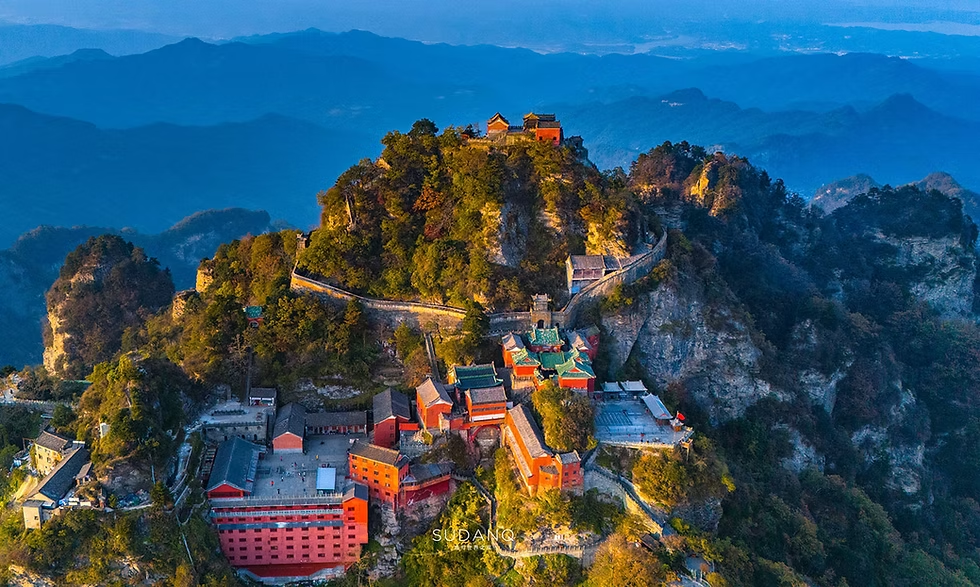As a seasoned traveler, I’ve explored countless destinations, but few places have left as deep an impression on me as the Wudang Mountains in Hubei Province, China. Known as the cradle of Taoism and the birthplace of Tai Chi, this UNESCO World Heritage Site offers a captivating blend of natural beauty, ancient architecture, and spiritual serenity. Whether you’re a history buff, a nature lover, or someone seeking a deeper connection with Chinese culture, the Wudang Mountains are a must-visit. Here’s my comprehensive travel guide to help you plan an unforgettable trip.








A Traveler’s Guide to the Wudang Mountains
Getting There
The Wudang Mountains are located near Shiyan City in northwestern Hubei. The most convenient way to reach them is by taking a high-speed train from Wuhan, which takes about 4 hours to Wudangshan Station. From there, a short taxi or bus ride (Bus 203) will get you to the mountain’s entrance in about 30 minutes. If you’re coming from Xi’an, there’s a daily flight to Shiyan, followed by a similar transfer. For international travelers, flying into Wuhan and connecting via train is the smoothest option. Always book tickets in advance, especially during peak seasons like spring and autumn.
Best Time to Visit
Spring (March to May) and autumn (September to November) are ideal, offering mild weather, blooming flowers, or vibrant foliage, respectively. Summer can be hot and humid, though the mountain’s elevation provides some relief, while winter brings a quieter, snow-dusted charm—perfect for those seeking solitude. Avoid weekends or major holidays like National Day (early October) to escape the crowds.
What to See and Do
Golden Summit (Jin Ding): Perched atop Tianzhu Peak at 1,612 meters, the Golden Summit is the crown jewel of Wudang. This Ming Dynasty temple, adorned with copper and gold, offers panoramic views of the 72 peaks bowing toward it—a sight that’s both humbling and breathtaking. Take the cable car from Qiongtai (90 RMB up, 80 RMB down) to save energy, or hike the ancient stone steps for a rewarding challenge. Sunrise here, with clouds swirling below, is pure magic.
Nanyan Temple: Clinging to a cliff, this temple is a masterpiece of Taoist architecture and a serene spot to soak in the scenery. The surrounding cliffs and forests make it a great place for photography or a quiet moment of reflection. It’s also a popular sunrise spot if you’re staying nearby.
Purple Cloud Palace (Zixiao Gong): One of the best-preserved temples on the mountain, this sprawling complex dates back to the 12th century. Its intricate wooden halls and tranquil courtyards offer a glimpse into Taoist life. Entry costs an extra 15 RMB, but it’s worth it to see priests practicing their rituals.
Tai Chi Experience: Wudang is the birthplace of Tai Chi, and you can join a short class at local academies or hotels (often 100-200 RMB/hour). Learning the flowing movements amid these sacred peaks is a bucket-list experience for martial arts enthusiasts or anyone seeking mindfulness.
Hiking and Nature: Beyond the temples, the rugged trails and lush valleys beckon. The path from Prince Slope (Taizi Po) to the Golden Summit is strenuous but scenic, weaving past streams and ancient pines. Bring sturdy shoes and water—stairs are plentiful and steep.
Where to Stay
Nanyan Area: For proximity to key sites, stay at guesthouses like You Jian Inn (affordable, with mountain pick-up services) or the more upscale Tai Chi Hotel. It’s quieter here than the western side.
Foothills: The Wudang Jianguo Hotel offers 5-star comfort with English-speaking staff and easy access to the entrance—ideal for a luxurious base.
Budget Tip: Book early, as options are limited, especially near the scenic spots. Two nights are perfect for a full experience; one night feels rushed.
Practical Tips
Tickets: The general admission is 140 RMB, covering the scenic area and shuttle buses (an additional 100 RMB). Extra fees apply for Golden Summit (20 RMB) and Purple Cloud Palace (15 RMB). Buy at the entrance or online to skip lines.
Transportation: Free shuttle buses run within the scenic area, connecting major sites. They’re efficient but stop around 5 PM, so plan accordingly.
Packing: Comfortable shoes, a light jacket (weather shifts fast), sunscreen, and a reusable water bottle are essentials. Bring cash—some vendors don’t take cards.
Language: English signage exists, but basic Mandarin phrases or a translation app will enhance your trip. Locals are friendly and curious about foreigners.
Safety: The area is safe, but stick to marked paths and watch your step on steep trails.
Food and Culture
Local eateries near Nanyan serve simple, hearty dishes like wild mushroom noodles, grilled fish, and Taoist vegetarian meals (think tofu and mountain greens). Try Wudang green tea—a crisp, local specialty perfect for souvenirs. Engage with the Taoist priests or monks if you can; their insights into the mountain’s spiritual legacy are invaluable.
Final Thoughts
The Wudang Mountains aren’t just a destination—they’re a journey into China’s soul. From the mist-shrouded peaks to the echoes of ancient wisdom, every step feels like a pilgrimage. As a seasoned traveler, I recommend pacing yourself, embracing the climb, and letting the mountain’s tranquility wash over you. Whether you’re here for a day or a week, Wudang will leave you with stories to tell and a longing to return. Pack your curiosity and go—it’s a place that rewards the adventurous heart.













